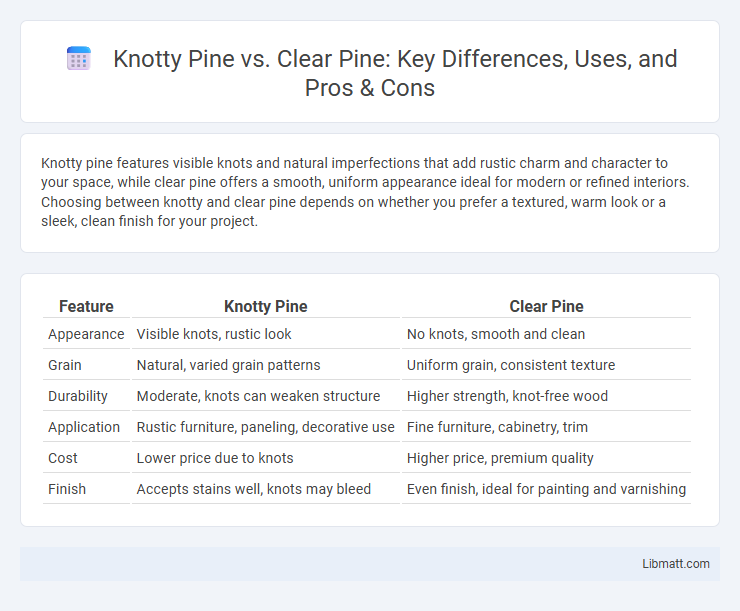Knotty pine features visible knots and natural imperfections that add rustic charm and character to your space, while clear pine offers a smooth, uniform appearance ideal for modern or refined interiors. Choosing between knotty and clear pine depends on whether you prefer a textured, warm look or a sleek, clean finish for your project.
Table of Comparison
| Feature | Knotty Pine | Clear Pine |
|---|---|---|
| Appearance | Visible knots, rustic look | No knots, smooth and clean |
| Grain | Natural, varied grain patterns | Uniform grain, consistent texture |
| Durability | Moderate, knots can weaken structure | Higher strength, knot-free wood |
| Application | Rustic furniture, paneling, decorative use | Fine furniture, cabinetry, trim |
| Cost | Lower price due to knots | Higher price, premium quality |
| Finish | Accepts stains well, knots may bleed | Even finish, ideal for painting and varnishing |
Introduction to Knotty Pine and Clear Pine
Knotty pine features prominent knots and natural imperfections that add a rustic, textured appearance to interior spaces, often used in cabins and traditional homes. Clear pine, in contrast, is characterized by its smooth, knot-free surface, offering a clean and uniform look ideal for modern or refined woodwork projects. Both types of pine come from the same species, but their distinct grain patterns and visual qualities suit different aesthetic preferences and applications.
Key Characteristics of Knotty Pine
Knotty pine features prominent, naturally occurring knots and a rustic grain pattern that adds character and warmth to interior spaces. Its texture includes swirls and imperfections, creating a distinct, vintage aesthetic compared to the smooth and uniform appearance of clear pine. The wood's durability and affordability make knotty pine a popular choice for paneling, furniture, and decorative accents.
Key Characteristics of Clear Pine
Clear pine is characterized by its smooth, uniform surface with minimal knots or blemishes, making it ideal for furniture and cabinetry where a clean appearance is desired. Its light color ranges from pale yellow to creamy white, enhancing its versatility in various interior designs. The wood's fine, straight grain and consistent texture contribute to its ease of sanding and finishing, offering a refined, polished look.
Aesthetic Differences: Knotty vs Clear Pine
Knotty pine features prominent knots and grain patterns that create a rustic, textured appearance, making it ideal for cozy, country-style interiors. Clear pine, on the other hand, offers a smooth, uniform surface with minimal imperfections, providing a cleaner, more polished look suitable for modern or minimalist decor. Your choice between knotty and clear pine will significantly influence the visual warmth and character of your space.
Durability and Strength Comparison
Knotty pine often contains more knots, which can create weak points affecting its overall strength, whereas clear pine is free of knots and offers more consistent durability and structural integrity. The presence of knots in knotty pine can lead to increased susceptibility to cracking and splitting under stress, making clear pine a preferred choice for applications requiring enhanced load-bearing capacity. Clear pine's uniform grain structure not only improves its strength but also enhances its resistance to wear, making it suitable for high-traffic or high-stress environments.
Common Uses for Knotty Pine
Knotty pine is commonly used in interior design for rustic wall paneling, ceilings, and cabinetry due to its distinctive knots and warm, natural appearance. It is a popular choice for cabins, lodges, and country-style homes where a cozy, textured wood aesthetic is desired. Unlike clear pine, knotty pine provides a more character-rich, visually interesting surface ideal for decorative applications.
Common Uses for Clear Pine
Clear pine is widely favored for furniture making, cabinetry, and interior paneling due to its smooth, uniform appearance and minimal knots that provide a clean, polished finish. Its durability and ease of staining make it ideal for decorative moldings, doors, and window frames where a refined look is essential. Using clear pine ensures Your woodworking projects achieve a professional, high-quality aesthetic suited for both residential and commercial applications.
Cost Differences and Budget Considerations
Knotty pine generally costs less than clear pine due to the presence of knots, which reduces its grade and price, making it a budget-friendly option for rustic or casual designs. Clear pine, free from knots and blemishes, commands a higher price as it offers a smooth, uniform appearance preferred in fine woodworking and finished interiors. Budget considerations should factor in the project's aesthetic goals and durability needs, with knotty pine suited for cost-conscious projects and clear pine chosen for premium, refined applications.
Maintenance and Care Requirements
Knotty pine requires more frequent maintenance due to its uneven surface and knots, which can trap dust and dirt, necessitating regular cleaning and occasional sanding to maintain its appearance. Clear pine, with its smooth, knot-free surface, is easier to clean and typically only needs periodic dusting and occasional polishing to preserve its finish. Both types benefit from protective finishes, but clear pine generally demands less upkeep to retain its aesthetic and structural integrity.
Choosing the Right Pine for Your Project
Knotty pine offers a rustic, textured appearance with visible knots that add character, making it ideal for cabins, accent walls, and furniture requiring a natural, rugged look. Clear pine, free of knots and imperfections, provides a smooth, uniform surface perfect for fine woodworking, cabinetry, and projects where a polished, high-quality finish is desired. Selecting between knotty and clear pine depends on whether your project demands aesthetic warmth and authenticity or a pristine, adaptable grain for staining and painting.
Knotty pine vs clear pine Infographic

 libmatt.com
libmatt.com